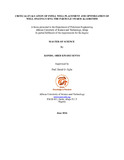| dc.description.abstract | Optimizing the placement of new wells and well spacing is a vital issue in oil field development. Drilling infill wells is one way to maximize the recovery of oil from reservoirs. The problem of infill well placement is challenging because many different well scenarios must be evaluated when undertaking the optimization program and very often, the variables that affect reservoir performance are nonlinearly correlated with some degree of uncertainty. Using computational algorithms has become common in handling the well placement problem.
This research seeks to employ an efficient optimization technique to solve the well placement problem by identifying the optimum locations of infill wells and their spacing in a reservoir model. Particle Swarm Optimization Algorithm (PSA) has proved to be an efficient tool in addressing well placement problems, and it was employed in this research as the main optimization algorithm. PSA is used to find the optimal locations for three cases by varying well spacing, i.e., 20 acres, 40 acres and 80 acres between wells in a reservoir model considered in this study. Several cases of infill well drilling were considered in the reservoir model containing six existing appraisal wells. After the findings, the optimum well locations, the number of wells and the corresponding well spacing was determined. An uncertainty analysis was conducted to evaluate the impact of the reservoir and economic parameters that directly affect the net present value, i.e., the objective function used in the optimization problem. The estimation of P10, P50, and P90 from the uncertainty analysis provided a basis to estimate the possible ranges of the net present values and the options for evaluating the reservoir development scenarios.
The major contribution of this work is that a methodology for infill well placement has been developed, it is a useful tool to support petroleum engineers in deciding how to maximize the value of their asset - the petroleum reservoir. | en_US |

